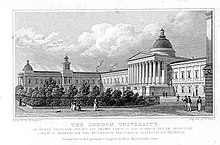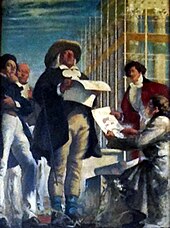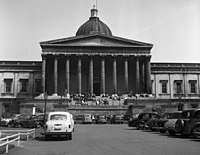loading...
Monday, 27 June 2016
University College London
1826 to 1836 (London University)

The London University as drawn by Thomas Hosmer Shepherd and published in 1827–1828 (now the UCL Main Building)
UCL was established on 11 February 1826 under the name London University as a common distinct option for the religious colleges of Oxford and Cambridge. London University's first Warden was Leonard Horner, who was the first researcher to head a British college.

Henry Tonks' 1923 mural The Four Founders of UCL
Regardless of the accepted way of thinking that the scholar Jeremy Bentham was the organizer of UCL, his immediate contribution was constrained to the buy of offer No.633, at an expense of £100 paid in nine portions between December 1826 and January 1830. In 1828 he did name a companion to sit on the chamber, and in 1827 endeavored to have his follower John Bowring designated as the first teacher of English or History, yet on both events his applicants were unsuccessful. This proposes while his thoughts may have been persuasive, he himself was less so. However Bentham is today regularly viewed as the "profound father" of UCL, as his radical thoughts on instruction and society were the motivation to the organization's authors, especially the ScotsmenJames Mill (1773–1836) and Henry Brougham (1778–1868).
In 1827, the Chair of Political Economy at London University was made, with John Ramsay McCulloch as the first occupant, setting up one of the first branches of financial aspects in England. In 1828 the college turned into the first in England to offer English as a subject and the educating of Classics and solution started. In 1830, London University established the London University School, which would later get to be University College School. In 1833, the college named Alexander Maconochie, Secretary to the Royal Geographical Society, as the first teacher of geology in the UK. In 1834, University College Hospital opened as a showing clinic for the college restorative sc


1836 to 2005
In 1836, London University was fused by Royal Charter under the name University College, London. Around the same time, the University of London was made by illustrious sanction as a degree-granting looking at load up for understudies from partnered schools and universities, with University College and King's College, London being named in the contract as the initial two offshoots.
The Slade School of Fine Art was established in 1871 after an inheritance from Felix Slade.
In 1878 the University of London picked up a supplemental sanction making it the first British college to be permitted to honor degrees to ladies. That year, UCL turned into the first school to concede ladies on equivalent terms to men in the resources of Arts and Law and of Science, in spite of the fact that ladies stayed banned from the resources of Engineering and of Medicine (except for courses on general wellbeing and cleanliness). Ladies were at long last admitted to restorative studies under the weight of the first world war in 1917, albeit after the war finished impediments were put on their numbers.
In 1898, Sir William Ramsay found the components krypton, neon and xenon whilst teacher of science at UCL.

William Ramsay is regarded as the "father of noble gases".
In 1900 the University of London was reconstituted as a government college with new statutes drawn up under the University of London Act 1898. UCL, alongside various different universities in London, got to be schools of the University of London. While the vast majority of the constituent establishments held their self-governance, UCL was converged into the University in 1907 under the University College London (Transfer) Act 1905 and lost its legitimate freedom.
1900 additionally saw the choice to name a salaried leader of the school. The primary officeholder was Carey Foster, who served as Principal (as the post was initially titled) from 1900 to 1904. He was succeeded by Gregory Foster (no connection), and in 1906 the title was changed to Provost to maintain a strategic distance from disarray with the Principal of the University of London. Gregory Foster stayed in post until 1929.
In 1906 the Cruciform Building was opened as the new home for University College Hospital.
UCL supported significant bomb harm amid the Second World War, including to the Great Hall and the Carey Foster Physics Laboratory. The principal UCL understudy magazine, Pi Magazine, was distributed surprisingly on 21 February 1946. The Institute of Jewish Studies moved to UCL in 1959. The Mullard Space Science Laboratory was built up in 1967. In 1973, UCL turned into the first global connection to the forerunner of the web, the ARPANET, sending the world's first email around the same time.
Despite the fact that UCL was the first college to concede ladies on the same terms as men, in 1878, the College's senior normal room, the Housman Room, remained men-just until 1969. After two unsuccessful endeavors a movement was passed that finished isolation by sex at UCL. This was accomplished by Brian Woledge (Fielden Professor of French at UCL from 1939 to 1971) and David Colquhoun, around then a youthful speaker in Pharmacology.
 The Wilkins Building in 1956
The Wilkins Building in 1956
 A contemporary view of the same
In 1976, another sanction restored UCL's legitimate autonomy, in spite of the fact that not the ability to honor its own degrees. It was likewise under this contract the College turned out to be formally known asUniversity College London (in this manner forsaking the comma after "School", which had been being used subsequent to 1836).
In 1986, UCL converged with the Institute of Archeology. In 1988 UCL converged with the Institute of Laryngology and Otology, the Institute of Orthopedics, the Institute of Urology and Nephrology andMiddlesex Hospital Medical School. In 1994 the University College London Hospitals NHS Trust was built up. UCL converged with the College of Speech Sciences and the Institute of Ophthalmology in 1995, the Institute of Child Health and the School of Podiatry in 1996 and the Institute of Neurology in 1997. In 1998 UCL converged with the Royal Free Hospital Medical School to make the Royal Free and University College Medical School (renamed the UCL Medical School in October 2008). In 1999 UCL converged with the School of Slavonic and East European Studies and the Eastman Dental Institute.
The UCL Jill Dando Institute of Crime Science, the first college office on the planet gave particularly to lessening wrongdoing, was established in 2001.
Proposition for a merger in the middle of UCL and Imperial College London were reported in 2002.The proposition incited solid resistance from UCL showing staff and understudies and the AUT union, which censured "the revolting scurry and absence of interview", prompting its deserting by the UCL Provost Sir Derek Roberts. The web journals that halted the merger, are protected, however a portion of the connections are presently broken: see David Colquhoun's website, and the somewhat more sleek Save UCL blog, which was controlled by David Conway, a postgraduate understudy in the division of Hebrew and Jewish contemplates.
The London Center for Nanotechnology was set up in 2003 as a joint endeavor in the middle of UCL and Imperial College London.
Since 2003, when UCL Professor David Latchman got to be Master of the neighboring Birkbeck, he has manufactured closer relations between these two University of London schools, and by and by keeps up offices at both. Joint examination focuses incorporate the UCL/Birkbeck Institute for Earth and Planetary Sciences, the UCL/Birkbeck/IoE Center for Educational Neuroscience, the UCL/Birkbeck Institute of Structural and Molecular Biology, and the Birkbeck-UCL Center for Neuroimaging.
A contemporary view of the same
In 1976, another sanction restored UCL's legitimate autonomy, in spite of the fact that not the ability to honor its own degrees. It was likewise under this contract the College turned out to be formally known asUniversity College London (in this manner forsaking the comma after "School", which had been being used subsequent to 1836).
In 1986, UCL converged with the Institute of Archeology. In 1988 UCL converged with the Institute of Laryngology and Otology, the Institute of Orthopedics, the Institute of Urology and Nephrology andMiddlesex Hospital Medical School. In 1994 the University College London Hospitals NHS Trust was built up. UCL converged with the College of Speech Sciences and the Institute of Ophthalmology in 1995, the Institute of Child Health and the School of Podiatry in 1996 and the Institute of Neurology in 1997. In 1998 UCL converged with the Royal Free Hospital Medical School to make the Royal Free and University College Medical School (renamed the UCL Medical School in October 2008). In 1999 UCL converged with the School of Slavonic and East European Studies and the Eastman Dental Institute.
The UCL Jill Dando Institute of Crime Science, the first college office on the planet gave particularly to lessening wrongdoing, was established in 2001.
Proposition for a merger in the middle of UCL and Imperial College London were reported in 2002.The proposition incited solid resistance from UCL showing staff and understudies and the AUT union, which censured "the revolting scurry and absence of interview", prompting its deserting by the UCL Provost Sir Derek Roberts. The web journals that halted the merger, are protected, however a portion of the connections are presently broken: see David Colquhoun's website, and the somewhat more sleek Save UCL blog, which was controlled by David Conway, a postgraduate understudy in the division of Hebrew and Jewish contemplates.
The London Center for Nanotechnology was set up in 2003 as a joint endeavor in the middle of UCL and Imperial College London.
Since 2003, when UCL Professor David Latchman got to be Master of the neighboring Birkbeck, he has manufactured closer relations between these two University of London schools, and by and by keeps up offices at both. Joint examination focuses incorporate the UCL/Birkbeck Institute for Earth and Planetary Sciences, the UCL/Birkbeck/IoE Center for Educational Neuroscience, the UCL/Birkbeck Institute of Structural and Molecular Biology, and the Birkbeck-UCL Center for Neuroimaging.


The Wilkins Building in 1956

A contemporary view of the same
2005 to 2010

The UCL School of Slavonic and East European Studies building, which was opened in 2005
In 2005, UCL was at long last allowed its own particular taught and research degree honoring forces and all new UCL understudies enrolled from 2007/08 qualified with UCL degrees. Likewise in 2005, UCL received another corporate marking, under which, in addition to other things, the name University College London was supplanted by the basic initialism UCL in every single outer correspondence. Around the same time a noteworthy new £422 million building was opened for University College Hospital on Euston Road, the UCL Ear Institute was set up and another building for the UCL School of Slavonic and East European Studies was opened.
In 2007, the UCL Cancer Institute was opened in the recently developed Paul O'Gorman Building. In August 2008 UCL shaped UCL Partners, a scholarly wellbeing science focus, with Great Ormond Street Hospital for Children NHS Trust, Moorfields Eye Hospital NHS Foundation Trust, Royal Free London NHS Foundation Trust and University College London Hospitals NHS Foundation Trust. In 2008 UCL set up the UCL School of Energy and Resources in Adelaide, Australia, the first grounds of a British college in the nation. The School is situated in the notable Torrens Building in Victoria Square and its creation took after transactions between UCL Vice Provost Michael Worton and South Australian Premier Mike Rann.
In 2009, the Yale UCL Collaborative was built up between UCL, UCL Partners, Yale University, Yale School of Medicine and Yale – New Haven Hospital. It is the biggest coordinated effort ever, and its extension has in this way been reached out to the humanities and sociologi

2010 to present

The Torrens Building in Adelaide, South Australia, which houses the UCL School of Energy and Resources
In June 2011, the mining organization BHP Billiton consented to give A$10 million to UCL to subsidize the foundation of two vitality establishments – the Energy Policy Institute, situated in Adelaide, and the Institute for Sustainable Resources, situated in London. In November 2011 UCL reported arrangements for a £500 million interest in its fundamental Bloomsbury grounds more than 10 years, and the foundation of another 23-section of land grounds by the Olympic Park in Stratford in the East End of London. It amended its arrangements of extension in East London and in December 2014 reported to assemble a grounds UCL East covering 11 sections of land and give up to 125,000m2 of space on Queen Elizabeth Olympic Park. UCL East will be a piece of the arranged Olympicopolis that plans to change the Olympic Park into a social and development center where UCL will open its first school of configuration, a focal point of trial designing and an exhibition hall without bounds, alongside a living space for understudies.
The School of Pharmacy, University of London converged with UCL on 1 January 2012, turning into the UCL School of Pharmacy inside of the Faculty of Life Sciences. In May 2012, UCL, Imperial College London and the semiconductor organization Intel declared the foundation of the Intel Collaborative Research Institute for Sustainable Connected Cities, a London-based establishment for exploration into the eventual fate of urban areas.
In August 2012 UCL got feedback for promoting an unpaid exploration position; it thusly pulled back the advert.
UCL and the Institute of Education framed a vital cooperation in October 2012, incorporating co-operation in instructing, exploration and the advancement of the London schools framework. In February 2014 the two foundations declared their goal to combine and the merger was finished in December 2014.
In October 2013 it was reported that the Translation Studies Unit of Imperial College London would move to UCL, turning out to be a piece of the UCL School of European Languages, Culture and Society. In December 2013, it was declared that UCL and the scholarly distributed organization Elsevier will team up to set up the UCL Big Data Institute. In January 2015 it was declared that UCL had been chosen by the UK government to be one of the five originator individuals from the Alan Turing Institute (together with the colleges of Cambridge, Edinburgh, Oxford and Warwick), an organization to be set up at the British Library to advance the improvement and utilization of cutting edge arithmetic, software engineering, calculations and Big Data.
In 2015 UCL built up another School of Management concentrated on innovation, development and business enterprise, supplanting its Department of Management Science and Innovation, with arrangements to move to new premises in One Canada Square, Canary Wharf in May 2016
